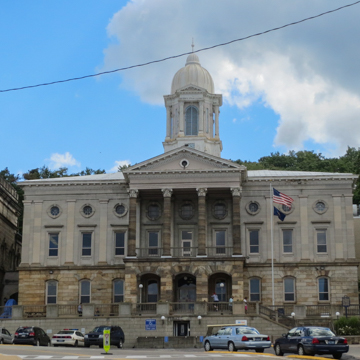The Armstrong County Courthouse, dramatically sited against a steep hillside at the eastern terminus of Kittanning's Market Street, is one of eight remaining Greek Revival courthouses in western Pennsylvania. Constructed by Hulings and Dickey for Barr and Moser, the courthouse includes features usually found late in the style's popularity. The pediment and four columns, the tall windows on the second floor, the roundels above, and the ornate cupola that crowns the building are all typical of the Greek Revival. However, the Roman Corinthian columns and the ground-floor windows topped with semicircular arches are characteristic of a newer fashion. The cruciform plan building has a wide stairway at the east, or rear, elevation. The interior was
You are here
Armstrong County Courthouse
1858–1860, Barr and Moser. 500 E. Market St.
If SAH Archipedia has been useful to you, please consider supporting it.
SAH Archipedia tells the story of the United States through its buildings, landscapes, and cities. This freely available resource empowers the public with authoritative knowledge that deepens their understanding and appreciation of the built environment. But the Society of Architectural Historians, which created SAH Archipedia with University of Virginia Press, needs your support to maintain the high-caliber research, writing, photography, cartography, editing, design, and programming that make SAH Archipedia a trusted online resource available to all who value the history of place, heritage tourism, and learning.















